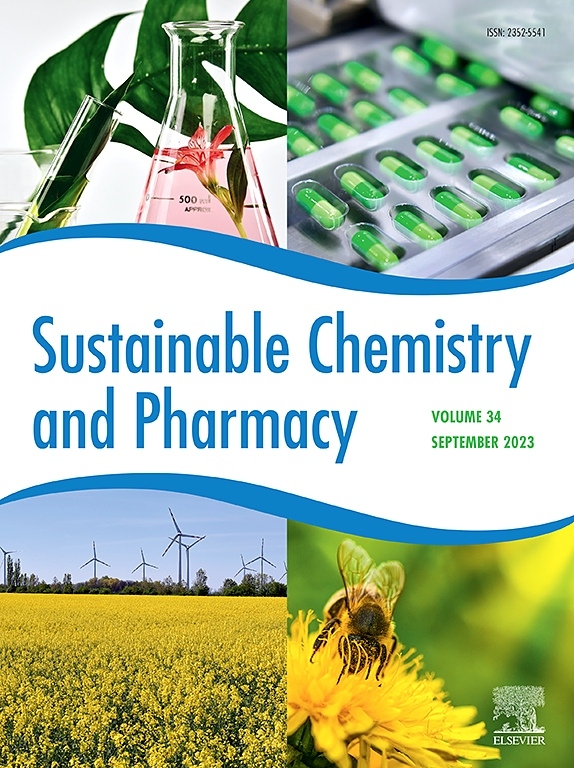Synthesis and photoinduced radical polymerization of bio-based methacrylates comprising one to three methacrylate groups
IF 5.8
2区 化学
Q2 CHEMISTRY, MULTIDISCIPLINARY
引用次数: 0
Abstract
Bio-based methacrylates substituted with one methacrylate group (9-hydroxy-10-methacryloyloxy iso-propyl stearate/9- methacryloyloxy-10-hydroxy iso-propyl stearate, 9-hydroxy-10-methacryloyloxy n-butyl stearate/9-methacryloyloxy-10-hydroxy n-butyl stearate) or two methacrylate groups (ethane-1,2-diyl-bis(9-methacryloyloxy-10-hydroxy octadecanoate)/ethane-1,2-diyl-9-hydroxy-10-methacryloyloxy-9′-methacryloyloxy-10′-hydroxy octadecanoate/ethane-1,2-diyl-bis(9-hydroxy-10-methacryloyloxy octadecanoate) and propane-1,3-diyl-bis(9-methacryloyloxy-10-hydroxy octadecanoate)/propane-1,3-diyl-9-hydroxy-10-methacryloyloxy-9′-methacryloyloxy-10′-hydroxy octadecanoate/propane-1,3-diyl-bis(9-hydroxy-10-methacryloyloxy octadecanoate)) were synthesized in three steps starting from oleic acid by esterification in the first step, epoxidation in the second step, and epoxy ring opening reaction with methacrylic acid in the third step. Further methacrylates were obtained from eugenol (1(1- methacryloyloxy-2-hydroxy propyl)-3-methoxy-4-lauroyloxy benzene/1(1-hydroxy-2-methacryloyloxy propyl)-3-methoxy-4-lauroyloxy benzene) and trioleine, respectively by epoxidation in the first step and epoxy ring opening reaction with methacrylic acid in the second step, and from cardanol (methacryloyloxy cardanol) by esterification of cardanol with methacryloyl chloride. Depending on the starting material for methacrylate synthesis, atom economy ranges from 12 % to 50 %. Furthermore, renewable carbon is between 58 % and 85 % for the methacrylates although it may increase up to 100 % if bio-based methacrylic acid would be used for monomer synthesis. The methacrylates were investigated in photoinitiated radical polymerization using photo-DSC. Significant differences were observed in both the polymerization rate and conversion of the methacrylates. Furthermore, soluble polymethacrylates were obtained from the monomethacrylates, although crosslinked films were received using photoinitiated polymerization of the dimethacrylates and the trimethacrylate. The crosslinked polymer films were investigated by DMA resulting in glass transition temperature and β-relaxation as well as crosslink density. Crosslinking of the bio-based methacrylates may be interesting for application in coatings and adhesives.

含有一至三个甲基丙烯酸酯基团的生物基甲基丙烯酸酯的合成和光诱导自由基聚合
以甲基丙烯酸酯取代的生物基甲基丙烯酸酯(9-羟基-10-甲基丙烯氧基异丙基硬脂酸酯/9-甲基丙烯氧基-10-羟基异丙基硬脂酸酯,9-羟基-10-甲基丙烯酰氧基硬脂酸正丁酯/9-甲基丙烯酰氧基-10-羟基硬脂酸正丁酯)或两个甲基丙烯酸基团(乙烷-1,2-二基-9-羟基-10-甲基丙烯酰氧基-9 ' -甲基丙烯酰氧基-10 ' -羟基十八酸酯)/乙烷-1,2-二基-二(9-甲基丙烯酰氧基-10-羟基十八酸酯)和丙烷-1,3-二基-二(9-甲基丙烯酰氧基-10-羟基十八酸酯)/丙烷-1,3-二基-二(9-甲基丙烯酰氧基-10-羟基十八酸酯)/丙烷-1,3-二基-二(9-甲基丙烯酰氧基-9 ' -甲基丙烯酰氧基-10 ' -甲基丙烯酰氧基-10 ' -羟基十八酸酯)以油酸为原料,经第一步酯化,第二步环氧化,第三步与甲基丙烯酸开环反应,三步合成十八酸酯/丙烷-1,3-二烷基-二(9-羟基-10-甲基丙烯酰氧基十八酸酯)。分别由丁香酚(1(1-甲基丙烯酰氧基-2-羟基丙基)-3-甲氧基-4-月桂酰氧基苯/1(1-羟基-2-甲基丙烯酰氧基丙基)-3-甲氧基-4-月桂酰氧基苯)和三油碱经第一步环氧化反应和第二步环氧开环反应得到甲基丙烯酸酯,腰果酚(甲基丙烯酰氧基腰果酚)经甲基丙烯酰氯酯化反应得到甲基丙烯酸酯。根据甲基丙烯酸酯合成原料的不同,原子经济性在12%到50%之间。此外,甲基丙烯酸酯的可再生碳含量在58%到85%之间,如果将生物基甲基丙烯酸用于单体合成,可再生碳含量可能会增加到100%。采用dsc法研究了甲基丙烯酸酯在光引发自由基聚合中的反应。甲基丙烯酸酯的聚合速率和转化率均有显著差异。此外,从单甲基丙烯酸酯得到可溶的聚甲基丙烯酸酯,尽管使用光引发聚合二甲丙烯酸酯和三甲基丙烯酸酯得到交联膜。用DMA法研究了交联聚合物薄膜的玻璃化转变温度、β弛豫和交联密度。生物基甲基丙烯酸酯的交联在涂料和胶粘剂中有很好的应用前景。
本文章由计算机程序翻译,如有差异,请以英文原文为准。
求助全文
约1分钟内获得全文
求助全文
来源期刊

Sustainable Chemistry and Pharmacy
Environmental Science-Pollution
CiteScore
8.20
自引率
6.70%
发文量
274
审稿时长
37 days
期刊介绍:
Sustainable Chemistry and Pharmacy publishes research that is related to chemistry, pharmacy and sustainability science in a forward oriented manner. It provides a unique forum for the publication of innovative research on the intersection and overlap of chemistry and pharmacy on the one hand and sustainability on the other hand. This includes contributions related to increasing sustainability of chemistry and pharmaceutical science and industries itself as well as their products in relation to the contribution of these to sustainability itself. As an interdisciplinary and transdisciplinary journal it addresses all sustainability related issues along the life cycle of chemical and pharmaceutical products form resource related topics until the end of life of products. This includes not only natural science based approaches and issues but also from humanities, social science and economics as far as they are dealing with sustainability related to chemistry and pharmacy. Sustainable Chemistry and Pharmacy aims at bridging between disciplines as well as developing and developed countries.
 求助内容:
求助内容: 应助结果提醒方式:
应助结果提醒方式:


